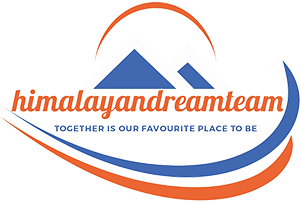Best Time to Trek Langtang & Gosaikunda Nepal | 2026–2027 Guide
Published On : 17th Nov, 2025 By Himalayan Dream Team
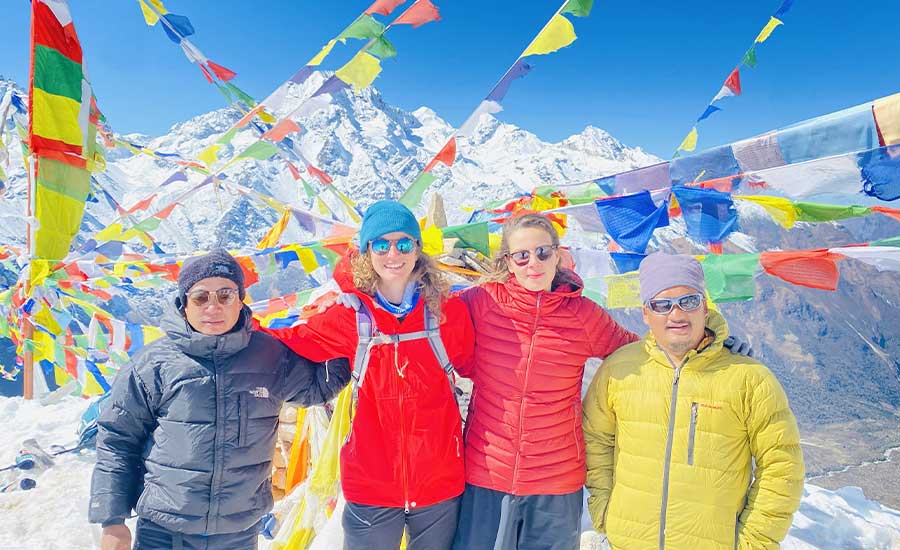
Best Time for Langtang & Gosaikunda Trek – Weather, Seasons & 13-Days Itinerary
If you are dreaming of a one-week to two-week trek close to Kathmandu that combines Himalayan scenery, local Tamang culture, holy lakes, and peaceful trails, the Langtang & Gosaikunda Trek is a beautiful choice. In just a short drive from the capital, you step into yak pastures, rhododendron forests, and glacial valleys framed by Langtang Lirung, Ganesh Himal, and Dorje Lakpa.
But one question decides how your whole journey will feel:
When is the best time for the Langtang & Gosaikunda Trek?
On behalf of Himalayan Dream Team, this guide explains the best season for Langtang and Gosaikunda, what to expect in every month, plus a day-by-day 13-day itinerary to help you start planning.
Quick Answer – Best Time for Langtang & Gosaikunda Trek
-
Best overall seasons:
Spring (March–May) and Autumn (September–November) -
For solitude & snow landscapes:
Winter (December–February) -
For lush greenery & fewer trekkers (but more rain):
Monsoon/Summer (June–August)
In Spring and Autumn, the weather is more stable, the days are pleasantly warm, the mountain views are crystal clear, and the trails are generally dry. That’s why most trekkers choose these months for the Langtang Valley Trek and the Langtang Gosaikunda Lake Trek.
Seasons in Langtang & Gosaikunda – What to Expect
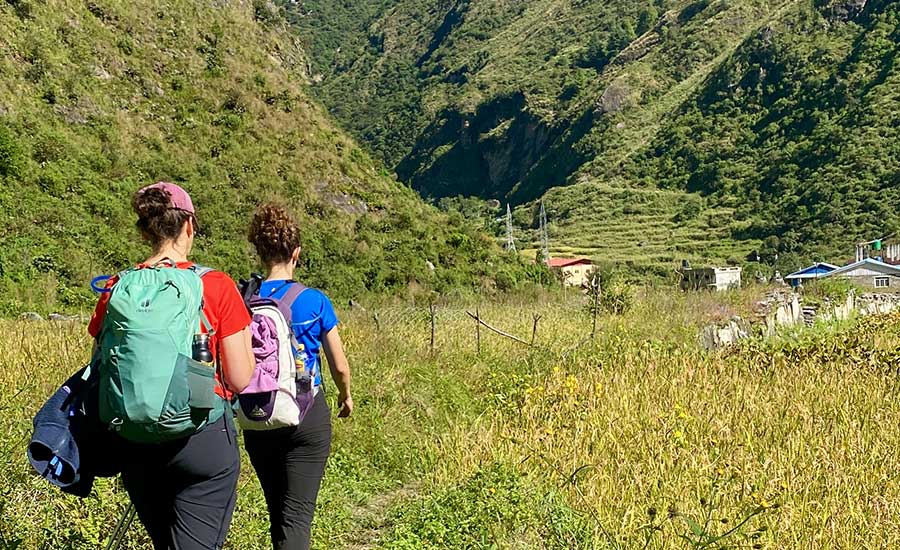
The Langtang region enjoys four distinct trekking seasons. Each brings its own character, views, and challenges.
1. Autumn (September–November) – Peak Season & Clear Mountain Views
If you want classic Himalayan trekking conditions, Autumn is your top choice.
-
Weather & Temperature:
-
Days are generally cool and comfortable, around 10°C–15°C at mid-altitude.
-
Mornings and evenings are colder, especially above 3,000 m.
-
-
Why trek in Autumn?
-
Post-monsoon skies are incredibly clear and blue.
-
Long-range views of Langtang Lirung, Ganesh Himal, Dorje Lakpa and distant peaks.
-
Low precipitation, so there is less chance of rain or heavy snowfall.
-
Dry, firm trails – perfect for steady walking and photography.
-
-
Festivals:
-
Major Nepali festivals like Dashain and Tihar bring color, music, and a joyful atmosphere to villages along the way.
-
Best for:
Trekkers who want the most reliable weather, amazing views, and a lively atmosphere on the trail.
2. Spring (March–May) – Rhododendrons & Warm, Longer Days
Spring is the second prime season for the Langtang Valley and Gosaikunda Lake Trek and is especially loved by nature lovers.
-
Weather & Temperature:
-
Daytime temperatures often range between 10°C–20°C.
-
Mornings can be crisp in early March, warming up steadily towards May.
-
-
Why trek in Spring?
-
Forests burst into color with rhododendrons, magnolias, and wildflowers.
-
Valleys are lush and green, with warm sunshine and soft mountain breezes.
-
Stable weather, with mostly clear mornings and occasional afternoon clouds.
-
-
Highlights:
-
Fresh leaves, new blossoms, and grazing yaks and horses in the meadows.
-
Excellent balance between comfortable walking temperatures and good visibility.
-
Best for:
Trekkers who love colorful landscapes, flowers, and slightly warmer conditions with great mountain views.
3. Summer/Monsoon (June–August) – Green Hills & Quiet Trails
Summer in Langtang overlaps with the monsoon season, bringing rain and vibrant greenery.
-
Weather & Temperature:
-
Warm and often humid at lower elevations, with temperatures up to 20–25°C in the valley.
-
Cooler at higher altitudes, but still milder than winter.
-
-
What to expect:
-
Frequent rain, particularly in the afternoons and evenings.
-
Trails can be muddy and slippery, with leeches and bugs at lower altitudes.
-
Cloud cover may hide the mountains for days, though views after rainfall are incredibly clear.
-
-
Upside:
-
The whole valley turns deep green – rice terraces, forests, and hillsides glow with life.
-
Fewer trekkers on the route, more peace and silence in the mountains.
-
Best for:
Nature-lovers who don’t mind rain and mud, and prefer quiet, crowd-free trails over guaranteed views.
4. Winter (December–February) – Snowy Silence & Crisp Blue Skies
Winter transforms Langtang and Gosaikunda into a snow-covered wonderland.
-
Weather & Temperature:
-
Daytime at mid-altitude: around 6°C–9°C.
-
Nights can drop well below freezing, especially above 3,000–4,000 m.
-
-
Why go in Winter?
-
Crystal-clear skies with sharp mountain panoramas.
-
Fewer trekkers, giving a sense of solitude and intimacy with the landscape.
-
Snow-blanketed valleys, frozen waterfalls, and icy lakes – especially around Gosaikunda.
-
-
Challenges:
-
Cold temperatures demand proper winter gear (down jacket, warm sleeping bag, microspikes).
-
Occasional heavy snowfall can make high passes and some lodges temporarily inaccessible.
-
Best for:
Experienced, well-equipped trekkers who love snow, quiet trails, and dramatic winter scenery.
Weather & Conditions by Month – Langtang & Gosaikunda (Overview)
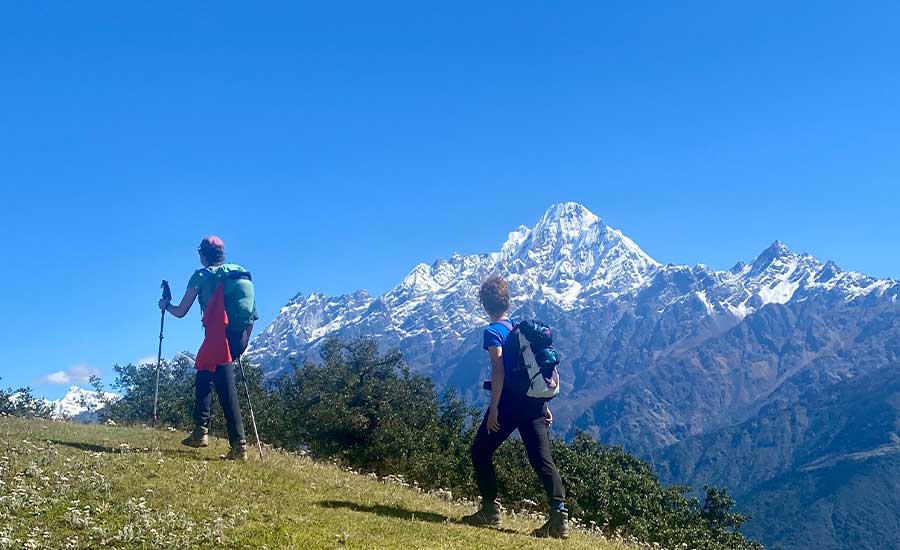
Below is a simple overview of typical conditions. Exact temperatures vary with altitude and yearly weather patterns, but this gives you a useful planning reference.
-
Jan–Feb: Very cold, clear skies, possible snowfall. Quiet trails and strong chances of snow views.
-
Mar–Apr: Warming up, stable weather, blooming forests, clear mornings – ideal trekking conditions.
-
May: Warm, sometimes hazy, with occasional pre-monsoon showers but still popular and beautiful.
-
Jun–Aug: Warm and wet, monsoon rains, lush greenery, but muddy trails and limited visibility.
-
Sep: Monsoon fading, improving visibility, still some wet patches, but great for early Autumn trekking.
-
Oct–Nov: The classic peak season – cool, dry, clear skies, and outstanding mountain panoramas.
-
Dec: Cold and quieter, with increasing chances of snow – great views for those prepared for winter.
Beyond Weather – What Else to Consider?
1. Festivals & Local Culture
The Langtang Gosaikunda Trek is not only about mountains; it’s also a spiritual and cultural journey.
Depending on your month, you may witness:
-
Janai Purnima & Gosaikunda Mela (August):
Pilgrims from all over Nepal hike to Gosaikunda Lake to bathe in its sacred waters, offer prayers, and tie sacred threads. A powerful, spiritual atmosphere surrounds the lakes. -
Maghe Sankranti (mid-January):
Winter festival celebrated with special food and gatherings in local villages. -
Nepali New Year / Bisket Jatra (April):
Colorful New Year celebrations in the Kathmandu Valley before or after your trek. -
Dashain & Tihar (October–November):
The biggest festivals in Nepal, with tika, jamara, lights, and joyful family celebrations.
If you want strong cultural immersion, let Himalayan Dream Team time your trek around one of these festivals.
2. Crowd Levels
-
Spring & Autumn:
Peak trekking seasons – more trekkers, more energy, but also busier tea houses. Early booking is recommended. -
Monsoon & Winter:
Much quieter trails and more room in lodges, but you must be ready for weather challenges (rain or snow).
If you prefer a balance, consider shoulder periods such as late March, early April, late November, or early December.
3. Acclimatization & Safety
The Langtang Gosaikunda Trek reaches altitudes above 4,000 m, with Laurebina La Pass around 4,610 m.
-
Walk at a steady pace, not in a hurry.
-
Drink plenty of water and eat nutritious meals in the tea houses.
-
Listen to your body – headaches, nausea, or dizziness can be signs of altitude issues.
-
Himalayan Dream Team’s local guides are trained to recognize altitude sickness and adjust the pace or itinerary if needed.
4. Permits for Langtang & Gosaikunda
For the Langtang Gosaikunda Trek, you typically need:
-
Langtang National Park Entry Permit
-
Shivapuri Nagarjun National Park Entry Permit (for the exit via Sundarijal side)
-
TIMS Card (Trekkers’ Information Management System)
Himalayan Dream Team can arrange all necessary permits in Kathmandu before your departure, so you can start your trek smoothly.
13-Day Langtang Gosaikunda Trek Itinerary
(Sample Itinerary by Himalayan Dream Team)
This classic route combines the Langtang Valley Trek with the sacred Gosaikunda Lakes and ends near Kathmandu – perfect if you want a complete experience close to the capital.
Day 1: Drive from Kathmandu to Syabrubesi (1,500 m)
After breakfast, you leave Kathmandu (1,335 m) and follow the Trishuli River by road. Terraced fields, hill villages, and distant Himalayan views accompany you as the road climbs past Dhunche and descends to the riverside town of Syabrubesi – the main gateway to Langtang.
-
Meals: Breakfast, Lunch, Dinner
-
Accommodation: Lodge
-
Driving Time: ~7–8 hours
Day 2: Trek Syabrubesi to Lama Hotel (2,480 m)
Your trek begins by crossing the Bhote Koshi and following the Langtang Khola upstream. The trail passes bamboo and subtropical forest where you may spot langur monkeys or even shy red pandas. After Bamboo and Rimche, a final gentle climb brings you to Lama Hotel, tucked into a forested valley.
-
Meals: Breakfast, Lunch, Dinner
-
Accommodation: Lodge
-
Walking Time: ~5–6 hours
Day 3: Lama Hotel to Langtang Village (3,430 m)
The path continues through oak and rhododendron woods before the valley gradually opens. At Ghoda Tabela, you’ll see signs of Tibetan resettlement and an army check post. Prayer wheels, mani walls, and fluttering flags guide you into Langtang Village, a traditional Tamang settlement surrounded by peaks.
-
Meals: Breakfast, Lunch, Dinner
-
Accommodation: Lodge
-
Walking Time: ~6–7 hours
Day 4: Langtang Village to Kyanjin Gompa (3,870 m)
Today is a shorter but spectacular walk. The forest thins out, the valley widens, and you cross small streams and yak pastures before reaching Kyanjin Gompa. This charming village is home to an ancient monastery and a local cheese factory, with wide-open views of Langtang Lirung and neighbouring peaks.
-
Meals: Breakfast, Lunch, Dinner
-
Accommodation: Lodge
-
Walking Time: ~4–5 hours
Day 5: Acclimatization & Hike to Kyanjin Ri or Tsergo Ri
You spend an extra day at Kyanjin to acclimatize and enjoy the scenery.
-
Option 1: Kyanjin Ri (≈4,773 m) – a shorter, steep climb with superb sunrise or sunset panoramas.
-
Option 2: Tsergo Ri (≈4,985 m) – a full, challenging day rewarding you with a 360° view of Yala Peak, Langtang Lirung, Ganja La range, Dorje Lakpa, and more.
Return to Kyanjin Gompa for a hot meal and a cozy lodge.
-
Meals: Breakfast, Lunch, Dinner
-
Accommodation: Lodge
Day 6: Kyanjin Gompa back to Lama Hotel (2,480 m)
You retrace your steps down the valley, enjoying a different angle on the mountains. Passing Langtang Village and Ghoda Tabela, you descend through forest to Lama Hotel.
-
Meals: Breakfast, Lunch, Dinner
-
Accommodation: Lodge
-
Walking Time: ~5–6 hours
Day 7: Lama Hotel to Thulo Syabru (2,200 m)
The trail descends towards the river and then climbs to the beautiful Tamang village of Thulo Syabru. Along the way you pass forests, waterfalls, and perhaps encounter wild boar or playful monkeys. From Thulo Syabru, there are lovely views towards Ganesh Himal and surrounding hills.
-
Meals: Breakfast, Lunch, Dinner
-
Accommodation: Lodge
-
Walking Time: ~5–6 hours
Day 8: Thulo Syabru to Cholangpati (3,650 m)
Today you steadily gain altitude through mixed forests of oak, hemlock, and rhododendron. After an army check post and the small monastery village of Sing Gompa (famous for its cheese), a further climb brings you to the quiet settlement of Cholangpati, a perfect stop before the high lakes.
-
Meals: Breakfast, Lunch, Dinner
-
Accommodation: Lodge
-
Walking Time: ~5–6 hours
Day 9: Cholangpati to Gosaikunda (4,380 m)
One of the most scenic days of the trek. You ascend past Laurebinayak with ever-widening views of Langtang Himal, Ganesh Himal, and even the distant Annapurnas. The path undulates along a ridge before the first holy lakes appear – Saraswati Kunda and Bhairav Kunda – and finally, the sacred Gosaikunda Lake, shimmering beneath snow-capped peaks.
-
Meals: Breakfast, Lunch, Dinner
-
Accommodation: Lodge
-
Walking Time: ~5–6 hours
Day 10: Gosaikunda to Ghopte via Laurebina La Pass (4,610 m)
You cross the highest point of the trek, Laurebina La Pass (≈4,610 m), decorated with prayer flags and stone cairns. From the pass, views drop away to both sides. A steep descent leads through rocky slopes and high valleys to Phedi and then on to the simple lodges of Ghopte (3,430 m).
-
Meals: Breakfast, Lunch, Dinner
-
Accommodation: Lodge
-
Walking Time: ~6–7 hours
Day 11: Ghopte to Kutumsang (2,470 m)
The trail winds through peaceful rhododendron and juniper forests. After reaching Tharepati, you enjoy a final sweep of mountain views before descending through pastures and small settlements to Kutumsang, a traditional hill village.
-
Meals: Breakfast, Lunch, Dinner
-
Accommodation: Lodge
-
Walking Time: ~4–5 hours
Day 12: Kutumsang to Chisapani (2,165 m)
You follow a ridge line through terraced fields and mixed forest, passing villages such as Gul Bhanjyang and Thorong Danda. The day finishes at Chisapani, known for its wide sunsets and sunrises over the Everest, Langtang, and Manaslu ranges on a clear day.
-
Meals: Breakfast, Lunch, Dinner
-
Accommodation: Lodge
-
Walking Time: ~6–7 hours
Day 13: Chisapani to Sundarijal & Drive to Kathmandu
Your final trekking day takes you through Shivapuri Nagarjun National Park, with dense forest, water reservoirs, and birdlife. A gradual descent leads to Sundarijal, from where you drive back to Kathmandu and check into your hotel – tired but full of memories from Langtang and Gosaikunda.
-
Meals: Breakfast, Lunch
-
Accommodation: Hotel
-
Walking Time: ~3–4 hours
Why Trek Langtang & Gosaikunda with Himalayan Dream Team?
-
Local, experienced guides who know the weather patterns and safe trail conditions.
-
Flexible departures to match your preferred season and festival dates.
-
Tailor-made itineraries – shorter Langtang Valley Treks or extended Langtang–Gosaikunda–Helambu routes.
-
Full support with permits, transport, accommodation, and gear advice.
Final Thoughts – When Is Your Best Time for Langtang & Gosaikunda?
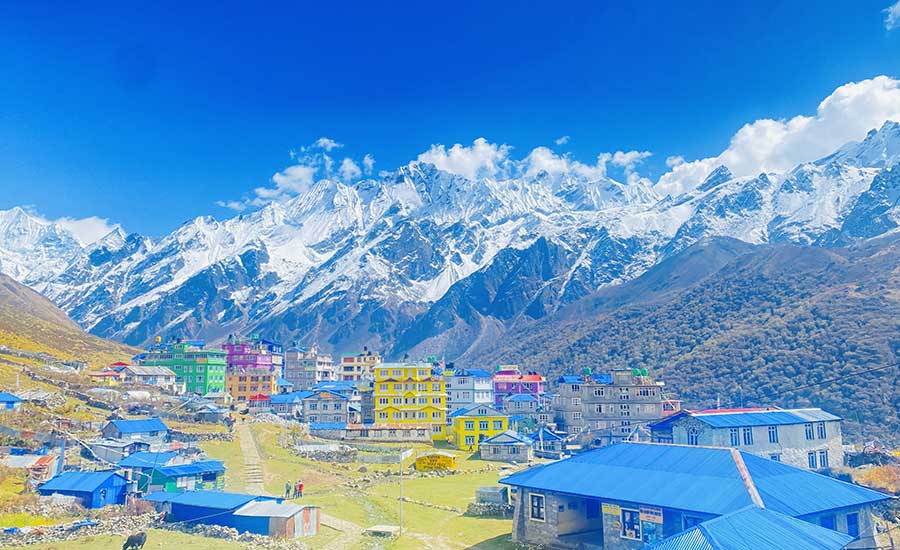
From flower-filled Spring to crisp Autumn skies, from quiet Winter trails to lush green Monsoon hills, every season in Langtang and Gosaikunda has its own charm. The “best time” is the one that matches your style of adventure:
-
Love sunshine, color, and stable weather? → Spring & Autumn
-
Prefer solitude and snow scenes? → Winter
-
Want greenery and don’t mind rain? → Monsoon
If you share your travel dates, fitness level, and preferences with Himalayan Dream Team, we will happily design the ideal Langtang or Langtang Gosaikunda Trek for you – in the season that suits you best.
Recent Posts

10th Nov, 2025

9th Nov, 2025

25th Oct, 2025

22nd Oct, 2025

17th Oct, 2025

17th Oct, 2025

13th Oct, 2025

12th Oct, 2025

9th Oct, 2025

5th Oct, 2025

3rd Oct, 2025

1st Oct, 2025

